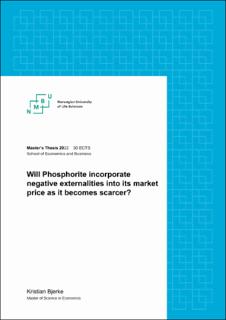Will Phosphorite incorporate negative externalities into its market price as it becomes scarcer?
Master thesis
Permanent lenke
https://hdl.handle.net/11250/3019189Utgivelsesdato
2022Metadata
Vis full innførselSamlinger
- Master's theses (HH) [1071]
Sammendrag
The increasing scarcity of Phosphorite poses a real threat to the world's food production. Global fertilizer production needs a steady phosphorus supply to cater to the global demand. Without Phosphorite, a new source of phosphorus must be found. As it stands today, no other substitute for Phosphorite fills the criteria of being both plentiful enough and economical to extract. Continued population growth and increased wealth also increase demand for both the amount and quality of food. This demand puts a considerable strain on the production of Phosphorite, leading to an over-extraction that is not compatible with economic theory regarding optimal use of non-renewable resources.
Continuing the extraction and beneficiation of Phosphorite creates compounding negative externalities in the form of phosphogypsum stacks and wastewater. These stacks, comprised of toxic and radioactive materials, are incredibly harmful to the environment. Dike breaches and spills from wastewater reservoirs cause irreparable damage to nearby waters and soil and can potentially destroy whole ecosystems if left unmanaged. Because Phosphorite is ultimately used for food production, these negative externalities are under-prioritized over the potential crisis if food demand is not adequately met. Therefore, current environmental policies targeting Phosphorite have no significant bearing on its price.
Today, the price of Phosphorite is dominated by short-term market behavior rather than longterm concerns of scarcity and the environment. This behavior is to be expected, as the production of Phosphorite is still increasing, meaning that a “peak phosphorus” situation is yet to occur. As long as the demand for food is met, there is no incentive to invest long-term, as doing so would lower funds available to invest for short-term profit. This situation will inevitably change once peak production has been reached. At this position, the demand for food can no longer be met, and it will ultimately be more profitable to invest in Phosphorite long-term, as its price must increase.
Around 80% of phosphorus is lost through the journey from extraction to the dinner table. Increasing the efficiency of production and reducing losses is therefore paramount to ensure a longer lifetime of Phosphorite. A longer lifetime of the resource creates more opportunities for technological progress and new methods of production without the looming disaster of a food shortage. This can therefore potentially solve the scarcity problem of Phosphorite in the long run.

